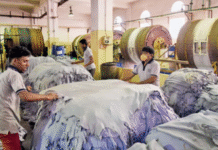With knitwear exports of over $2 billion a year, India’s garment manufacturing hub Tirupur has earned the nickname “Dollar City,” but its allure for price-conscious global retailers obsessed by discounts of as little as one US cent pales before Bangladesh.
Indian and Southeast Asian apparel manufacturers had hoped the orders would come flooding in, after the deadly collapse of a Bangladesh garment factory complex this year galvanised global brands such as Hennes & Mauritz AB (H&M) to consider relocating production.
But several industry organizations and factories contacted by Reuters in Vietnam, Cambodia, Indonesia, Sri Lanka and India – Asia’s top apparel makers outside China – said international retailers were not beating a path to their door just yet. When it comes to price, Bangladesh is king.
“The reason Bangladesh went from zero to hero in the garment sector is because there is no country with such low labour and other costs,” said Arvind Singhal, chairman of India-based retail consultancy Technopak Advisors.
“No buyer is in a hurry to move from Bangladesh because Western retailers are stressed about passing any retail price increases to customers,” he said. “Currently, there is no substitute for Bangladesh, where manufacturers even risk operating from rickety structures to cap costs.”
Wal-Mart Stores Inc has stood by its Bangladesh production, saying the South Asian nation remains an important sourcing market. H&M also said its quest for alternative manufacturers was not at the expense of Bangladesh.
“We are not reducing our purchases from Bangladesh. We aspire to have long-term relations with our suppliers,” H&M spokeswoman Elin Hallerby said. “We are always looking at new production capacity to support our continuous expansion.”
The latest data from Bangladesh highlights its enduring appeal: garment exports in June rose 26 percent year-on-year to $2.2 billion.
COST IS KING
More than four million people, mostly women, work in Bangladesh’s clothing sector, making it the second-largest global apparel exporter behind China.
The world’s biggest fashion retailers, Inditex SA and H&M, as well as Wal-Mart, Gap Inc and JC Penney Company Inc are a few of the brands manufacturing there.
The $21 billion-a-year industry has been built on low wages, government subsidies and tax concessions from Western countries. But the collapse of the Rana Plaza factory complex outside Dhaka in April raised concerns about safety loopholes. The disaster, one of the world’s worst industrial accidents, killed 1,132 people.
The collapse prompted global brands to consider tapping regional alternatives.
Indonesian textile firm Sri Rejeki Isman PT (Sritex), which makes clothing for Zara, H&M and other brands, said it was in talks with H&M about taking over an as yet unspecified amount of Bangladesh-sourced production. H&M declined to comment.
But as large factory owners across the region discovered, translating talks into orders is difficult as, compared to Bangladesh, they are considered too expensive.
“Garments produced in Bangladesh have a very competitive price, around two-to-three times lower than in Vietnam,” said Nguyen Huu Toan, deputy director of SaiGon 2 Garment JSC, a Vietnam factory whose clients include British fashion retailers New Look and TopShop.
The cost disadvantage also impacts Sri Lanka’s $4 billion-a-year garment industry, and factory owners there say any shift in production from Bangladesh will be transient.
“We are much better than any other country in the region, but it is a temporary advantage,” said Tuly Cooray, the secretary-general of industry group Joint Apparel Association Forum. “At the end of the day, the price is going to matter.”
NOT CUT FROM THE SAME CLOTH
The economic slowdown in Europe and the United States has made retailers all the more keen to seek out the lowest-cost manufacturing centers to keep their store prices down.
N. Thirukkumaran, owner of Tirupur-based apparel maker Estee which racked up $8.3 million in sales last year, said he holds marathon haggling sessions with foreign customers demanding discounts as little as one cent per unit.
At least one US retailer asked about moving production from Bangladesh, he said, but they have yet to place orders. Thirukkumaran would not name the brand, citing client confidentiality.
“There are positive signals from buyers, but they are still sceptical about price,” he added.
Monthly minimum salaries for garment sector workers in Bangladesh average around $38, far below the $100 average for Indian factory workers.
After the Rana Plaza collapse, the cabinet approved changes to the labour laws that pave the way for garment workers to create trade unions without the approval of factory owners.
The cabinet also formed a wage board to consider pay increases. But industry experts say Bangladesh has too much to lose by alienating global retailers, which means that for now, the low costs are here to stay.
“No other destination has what we have and that is skilled and cheap labour,” said Mohammad Mujibur Rahman, Bangladeshi academic leading factory inspections.
“Foreign buyers realize this and nobody is in a hurry to move out … there might be a small trickle outside, but nothing significant that will hurt us.”
Source: The Daily Star









